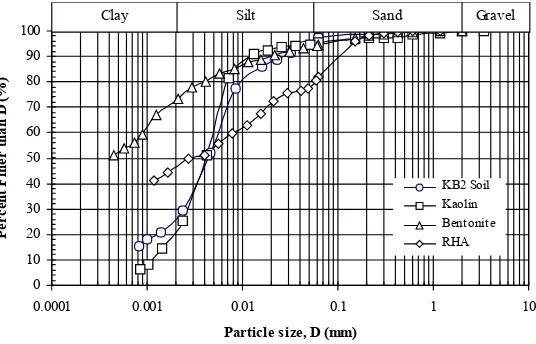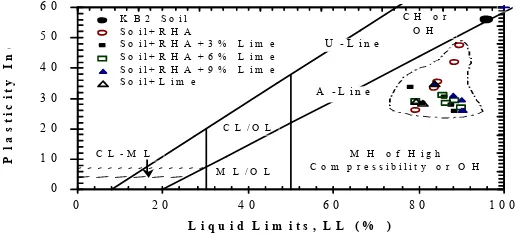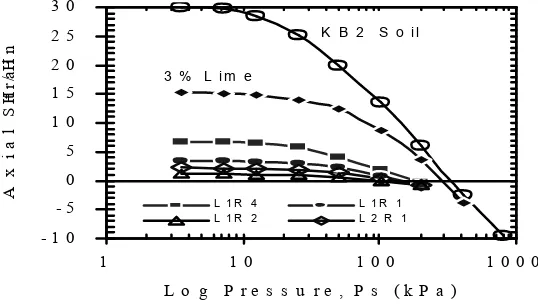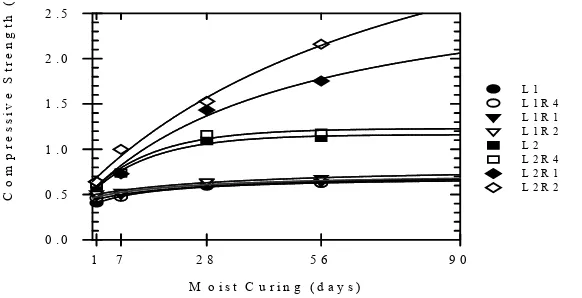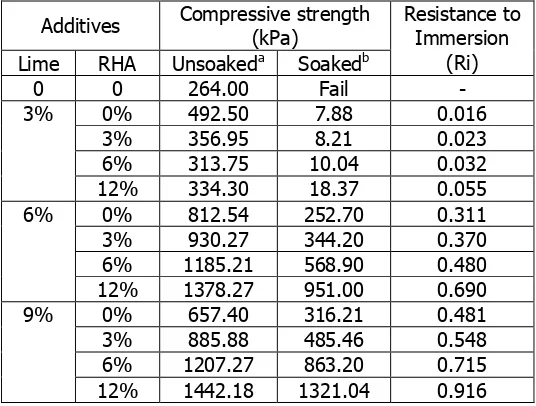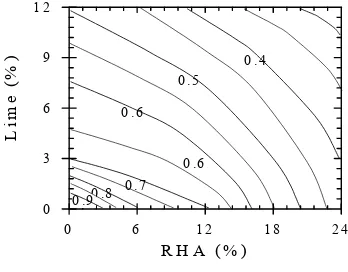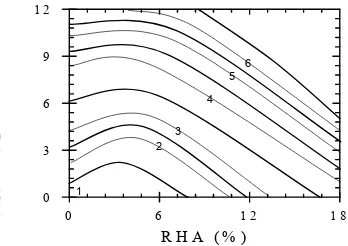GEOTECHNICAL PROPERTIES OF RICE HUSK ASH ENHANCED
LIME-STABILIZED EXPANSIVE CLAY
Agus Setyo Muntohar1
ABSTRAK
Penambahan dan pencampuran kapur atau semen dengan tanah mengembang merupakan tanah cara yang paling banyak digunakan untuk stabilisasi tanah. Dalam penelitian ini digunakan abu sekam padi guna meningkatkan kualitas stabilisasi tanah mengembang dengan kapur. Naskah ini menyajikan pengaruh penambahan abu sekam padi tersebut terhadap sifat-sifat geoteknis tanah yang distabilisasi dengan kapur. Hasil penelitian menunjukkan bahwa abu sekam padi mampu meningkatkan sifat-sifat geoteknis dengan sangat baik. Berdasarkan hasil penelitian ini dibuatkan pula grafik sebagai acuan untuk perencanaan pencampuran komposisi kapur dan abu sekam padi dalam stabilisasi tanah mengembang.
Kata kunci : sifat-sifat geoteknis, abu sekam padi, stabilisasi dengan kapur, tanah mengembang, rancangan campuran.
1 Senior Lecturer, Department of Civil Engineering,
Muhammadiyah University of Yogyakarta, Yogyakarta. INTRODUCTION
Expansive soils is world wide occurring and has been reported in numerous countries including Indonesia, India, Cina, Saudi Arabia, Turkey, and United States (Muntohar, 2002; Rao et. al, 2001; Shi et. al, 2002; Abduljauwad and Al-Suleimani, 1993; Erguler and Ulusay, 2003; Chen, 1983). Expansive soils, particularly those located in arid and semi-arid climate regions represent a problem. Geotechnical engineering community have long recognized that expansive soils may result in considerable distress and consequently in severe damage to overlying structures, particularly to low-rise structures, roads, and buried lifelines. Numerous reports of expansive soil problems and related damages have been documented in different countries (Chen, 1983).
The detrimental effects of expansive soils can be mitigated by means of stabilization. Soil stabilization may involve a range of treatment, which modifies soils to meet
specific engineering requirement and weather resistance. There are a number of methods which can be used to minimize swelling of expansive soils for example by compaction control, prewetting, preventing water content, and by chemically modifying soil properties (Gromko, 1974). The success of any stabilization method depends upon a consideration of soil conditions and an understanding of the application and limits of that particular method. Chemical stabilization of expansive soils by chemical additives such as lime, cement, fly ash, and other chemical compound have been widely applied for many years with varying success. The selection of a particular additive depends on costs, benefits, availability, and practicability of its application.
blast-furnace slag (GGBS). These materials can be grouped as secondary stabilizing agents that are not very effective on their own but can be usefully used in conjunction with lime or cement. Sometimes, only small proportion of cement or lime is needed as an activator and the secondary agents may comprise the major proportion of the stabilizer. Secondary materials may be available locally, in quantities that provide an economic binder system, without compromising technical properties. Further more, blended secondary stabilizing materials with lime or cement can have added technical advantages, such as reduces permeability and increases durability and strength. This paper presents the study of RHA utilization to enhance lime-stabilized expansive soil.
Needs for study
The utilization of RHA in geotechnical application has not been readily acceptable due to low level of confidence in its effectiveness among geotechnical engineers. For this reason, there is a need to fill the gaps currently hindering the full potential of RHA to be harness. The study presented in this paper aimed to provide further understanding and guidance on the use of RHA as soil stabilizer in particular for expansive soils.
LIME AND LIME-RHA STABILIZATION Lime stabilization is extensively applied for expansive clay soils. This stabilization develops from base exchange and cementation processes between clay particles and lime. Lime stabilization is particularly important in road construction for modifying subgrade soils, subbase, and base materials (Little, 2000). The stabilization process occurs for over a long period of time. In the shorter-term, lime modifies and immediately improves workability, placeability, compactability of soils, and effectively shrinks the construction costs (ICI, 1986). The initial
modification reaction occurs as a result of cation exchange of calcium ions (Ca2+). The
result of cation exchange is increasing flocculation of clay particles and changes in the plasticity properties of clay (Boardman, et al, 2001). The cementation process develops from the reaction between calcium present in lime and silica and alumina in the soil, forming calcium-silicate hydrate (CSH) and aluminate (CAH) or calcium-aluminate-silicate. The cementitious compounds produced are characterized by their high strength and low-volume change. Various conclusions have been deduced by previous researchers concerning uses of blended rice husk ash with lime or cement. Lazaro and Moh (1970) concluded that the addition of RHA in combination with lime to both Thai and Philippine soils does not produce any significant increasing of strength as compared to the use of lime alone. Whereas, Ali et al. (1992) pointed out that both of lime-stabilized and cement-stabilized residual soils from Malaysia enhance the strength and durability by adding RHA. Balasubramaniam et al. (1999) and Muntohar and Hantoro (2000) showed that addition of RHA to lime-stabilized soils exhibits ductile behavior associated with high strain and low strength.
TEST PROGRAM Materials used
0 10 20 30 40 50 60 70 80 90 100
0.0001 0.001 0.01 0.1 1 10
Particle size, D (mm)
Pe
rc
en
t F
in
er
th
an
D
(%
)
KB2 Soil Kaolin Bentonite RHA
Clay Silt Sand Gravel
Figure 1. Grain Size Distribution Curves of Soil Used and RHA
The hydrated lime was used in this research. To reduce the carbonation effect, the lime was stored in an airtight container. Rice husk ash was obtained by burning the rice husks in an incinerator. The husks were collected from rice mills disposal in Kuala Selangor, Malaysia. X-ray diffraction test, Figure 2, shows that the RHA possessed amorphous silica, while the lime was comprised of predominantly calcium hydroxide, Ca(OH)2.
Sample Preparation For Swelling And Compressive Strength Tests
A conventional oedometer apparatus was used for the determination of the swelling and compressibility of soil mixtures. Required quantities of soil mixtures, at optimum moisture content, were transferred to consolidation ring of 50 mm internal diameter and 20 mm height. All the soil mixtures were compacted statically to their MDD and OMC. Unconfined compressive strength was used to observe the strength. The samples, 50 mm diameter and 100 mm heights, were compacted at their maximum dry density by static compaction method. The calculated amount of soil was placed
into cylindrical mould and then compressed using the hydraulic jack.
Testing Program
The focus of this study is to investigate the effect of adding RHA on the geotechnical properties of lime-stabilized expansive soils. Toward this aim, the aspects studied covers consistency limits, swelling, compressive strength and durability of stabilized soil.
RESULTS AND DISCUSSION
Effect of Stabilization on Consistency Limits
10 15 20 25 30 35 40 45 50 55 60
Diffraction Angle (2)
C
Figure 2. X-Ray Diffraction Test of Lime And Rice Husk Ash
RHA (%)
Figure 3. Effect of RHA addition on consistency limit of lime-stabilized expansive soil (Note: numbers in percents are referring to percentage of lime content.
It was observed that there is different behavior in reduction of plasticity index with different stabilizers. The plasticity index of RHA-treated soil reduced significantly the plasticity index as the liquid limits diminished and increased in plastic limits. The liquid limit and plastic limit of lime-stabilized soil increase in conjunction with addition of RHA as shown in Figure 3a and Figure 3b respectively. The plastic limit increased steeply concomitantly reducing the plasticity index. The effect of
RHA-stabilized can be attributed non-plastic properties of RHA rather than cementitious reaction between soil and RHA. Soil lime RHA mixtures were identified to result cementitious reaction forming cementing agent that coat and bind clay particles to become coarser. The coarser particles would lead to random/flocculated particles arrangement and alter the plasticity as shown in Figure 4.
to the water content arises from the water entrapped in large void spaces of the flocculated soil fabrics (Prakash et al., 1989). Thereby, it explains the increased in the liquid limits as discussed earlier. Stiffening (self-hardening) of lime-RHA
treated soil requires greater amount of moisture to enhance workability i.e. to enable rolling to a 3 mm thread. Hence, the plastic limits increased in conjunction with the addition of lime and RHA.
0
Figure 4. Plasticity chart of stabilized expansive soil
Effect of Stabilization on Swelling Characteristics
The effect of lime and RHA addition to expansive soils is shown in Figure 5. The swell was measured for 10 days of inundation after 1-day moist cured under a seating pressure, and then the swelling pressure is determined by increasing the load such that the initial height of the specimen was recovered. The figure depicts decreasing of swelling and swelling pressure corresponds to addition of lime.
When lime was added to a clay soil, it has an immediate effect on the properties of the soil. Cation exchange begins to take place between the ions associated with the surfaces of the clay particles and the calcium ions of the lime. Clay particles are surrounded by a diffuse hydrous double layer, which was modified by the ion exchange of calcium. This alters the density of the electrical charge around the clay particles, which lead to them being attracted closer to each other to form flocs. It is a process which is responsible for loss of
plasticity in clay. It reduces the tendency of clay to swell. In addition to cation exchange, reaction occurs between the silica and some alumina of the lattices of the clay minerals, especially at the edges of clay particles. The reaction products contribute to flocculation by bonding adjacent soil particles together and as curing occurs, they strengthen the soils.
Lime content (%)
Figure 5. Effect of Lime and RHA on the Swelling and Swelling Pressure of Stabilized Soil
On the other hand, the addition of RHA will fill in the intervoid of soil particles. This causes reduction of permeability and compressibility. Concomitantly, the swelling and swelling pressure decrease appreciably. The compressibility, in this research, is performed after the soil has been allowed to cease its swell and then is loaded gradually. Typical swelling and compressibility curves of stabilized expansive soils with lime and RHA are illustrated in Figure 6.
The figure showed that the swollen soils (unstabilized) experienced steep reduction in volumetric strain compared to stabilized
expansive soil when loading took place. The swollen soil absorbed much water causing the soil to become highly compressible when subjected to load. It was observed that the inflection pressure was about at 50 kPa. Expansive soils stabilized with lime/RHA produced a denser soil structure as a result of cementitious reaction. Figure 6 illustrates that addition of lime/RHA minimize the compressibility of stabilized expansive soils. The whole results verify that addition of RHA into lime-treated soils reduces significantly the swelling, swelling pressure and compressibility.
Figure 6. Typical of Swelling Compressibility of Stabilized Expansive Soils (Note: L1R4: 3% Lime + 3% RHA, L1R1: 3% Lime + 6% RHA, L1R2: 3% Lime + 12% RHA, L2R1: 6% Lime +
Effect of Stabilization on Unconfined Compressive Strength
The effect of RHA addition on compressive strength of lime treated-soil after 1 day and 28 days of curing is presented in Figure 7a and Figure 7b respectively. The optimum lime content for the improvement of compressive strength was 6% of dry weight. It was observed that adding RHA to 3% lime does not significantly increase the strength. It can be simply explained that below the optimum lime content, the reaction of lime with kaolin/bentonite may still be attributed to ion exchange or minor
pozzolanic activity as investigated previously by Boardman et al. (2001). Concomitantly, the strength developed at a relatively slower rate. The addition of RHA will fill in the void of soil and react with lime to form cemented materials. The presence of excess RHA will then be regarded as redundant particles. Samples with higher lime content, basically, have greater pozzolanic activities. The presence of pozzolanic materials such as RHA with higher lime percentage will form a greater quantity cementitious material. This change can largely result in flocculation of fines particles to form bigger particles through agglomeration.
Figure 7. Effect of RHA Addition on the Unconfined Compressive Strength of Lime-Treated Soil.
M o i s t C u r i n g ( d a y s )
The long-term strength of stabilized soils may increase due to pozzolanic reactions. The results showed that the increase in curing has a substantial effect on the unconfined compressive strength. Figure 8 shows the effect of curing on compressive strength of lime stabilized soil mixtures. This figure, again, exhibits that a higher lime percentage produces higher strength. For all samples, generally, at least 60% of the strength was achieved after 1 2 weeks of curing, while further increases in strength after 2 weeks is observed to be marginal or negligible.
Effect of Stabilization on Resistance to Immersion
A stabilized soil should be durable in which it has ability to retain its integrity and
strength under service environmental conditions. The conformity to this requirement is more critical when the strength of the stabilized soils is low. The determination of the durability properties of the soils mixtures is a problem since it is difficult to simulate the detrimental action in laboratory comparable to that produced by weathering in the field. A simple method was examined by evaluating the compressive strength of the cylindrical specimens (50 mm diameter x 100 mm height) after 7 days of immersion in water. The specimens were moist-cured for 7 days and then capillary-soaked for 7 days. The ratio of compressive strength of soaked specimens and moist-cured specimens was then termed as resistance to immersion (Ri) as presented in Table 1.
Table 1. Unconfined compressive strength of soaked and unsoaked specimens
Additives Compressive strength(kPa) Lime RHA Unsoakeda Soakedb
Resistance to Immersion
(Ri)
0 0 264.00 Fail
-3% 0% 492.50 7.88 0.016
3% 356.95 8.21 0.023
6% 313.75 10.04 0.032
12% 334.30 18.37 0.055
6% 0% 812.54 252.70 0.311
3% 930.27 344.20 0.370
6% 1185.21 568.90 0.480
12% 1378.27 951.00 0.690
9% 0% 657.40 316.21 0.481
3% 885.88 485.46 0.548
6% 1207.27 863.20 0.715
12% 1442.18 1321.04 0.916
Note: a 14 days moist curedbThe specimens subject to 7 days moist cured and 7 days capillary soaked
under water.
Figure 9 presents the resistance to immersion of stabilized soil-mixtures with different method of treatment. In general, the stabilized soil experienced reduction in
in strength. Adding RHA to soil samples would help to increase the resistance to immersion. Fig. 9 also depicts that stabilized clay with 3 % failed to retain their structural integrity, which the strength lost is exceeding 90% subjected to immersion.
Adding RHA to 3% lime-stabilized soil did not significantly increased the durability. Increases in lime and rice husk ash content served to increase the percentage of cementitious materials which led to lower permeability and higher strength.
R H A c o n t e n t ( % )
0
3
6
9
1 2
1 5
R
e
s
is
ta
n
c
e
t
o
I
m
m
e
rs
io
n
0 . 0
0 . 2
0 . 4
0 . 6
0 . 8
1 . 0
3 % L i m e 6 % L i m e 9 % L i m e
Figure 9. Effect of Addition of Lime/RHA to Resistance to Immersion
X-Ray Diffraction (X-RD)
X-ray diffraction is the most widely used method to identify fine-grained soil minerals. It was observed in Figure 10 that swelling clay mineral, montmorillonite, strongly appeared at 15.32 Å in the tested soil. The presence of the kaolinite mineral was strongly found at 7.16 Å and 3.57 Å. Quartz and illite appeared strong at 3.35 Å and 3.19 Å respectively. The montmorillonite peak disappeared at 15.32 Å of basalt spacing (CuK
lime and RHA were blended with expansive
5 10 15 20 25 30 35 40 Diffraction Ang le (2)
E K
C
Q
K B: 1 0 % Ben t o n it e + 9 0 % K ao lin M ix t ures
6% Lime + 3% RHA 6% Lime + 6% RHA 6% Lime + 12% RHA
6% Lime K
K
K K K
Q
Q
Q CSHc
CSHg
CSHg
CSHc
CSHc
CSHc
Note: I: Illite, K: Kaolinite, M: Montmorillonite, Q: Quartz, E: Ettringite, CSHg: calcium silicates hydrate (gel)
CSHc: calcium silicates hydrate (crystallized), CAS: calcium aluminate silicates hydrate
Figure 10. X-Ray Diffraction Pattern (Cuk
(d )
R H A (% )
0 6 1 2 1 8 2 4
L
im
e
(%
)
0 3 6 9 1 2
0 .5 0 .4
0 .7 0 .6
0 .6 0 .8
0 .9
Figure 11. Mixtures Design Chart Based on the Reduction of Plasticity Index (Note: numbers on the chart are referring to the
plasticity index ratio of stabilized to unstabilized soil)
Mixtures design of lime-RHA stabilized expansive soil
Lime RHA stabilization has provided structural improvement due to tested expansive soils. This research proposed a design chart as an approximate mixtures
R H A ( % )
Figure 12. Mixtures Design Chart Based on the Increasing of Unconfined Compressive Strength (Note: numbers on the chart are referring to the compressive strength ratio
of stabilized to unstabilized soil)
CONCLUSIONS
Based on the experimental findings of this research the following conclusions can be outlined:
1. In general, addition of RHA solely decreases the plasticity of expansive soil, as a result of reducing liquid limit and increasing plastic limit. Addition of RHA significantly reduce the plasticity index, whereas as much as 80% of reduction is achieved by addition of RHA in greater lime content. It is noticed that 6% lime addition is enough to improve the consistency limits of expansive soils.
2. The swelling and swelling pressure of expansive soils decrease in concomitant with the addition of lime and RHA. The swelling of expansive soil is almost zero when it is added with 6% lime and 6% RHA.
3. Addition of RHA to lime stabilized expansive soil increases enormously the value of unconfined compressive strength. In general, the stabilised soil loses the unconfined compressive strength subjected to the immersion. Lime-stabilised soils alone lose in
strength greatly. Adding of RHA is able to increase the resistance to immersion. 4. Presences of cementitious materials such as calcium silicate hydrates (CSH) gel and calcium aluminate silicate hydrates (CAS) are detected in the lime-RHA treated expansive soil. Indicating the pozzolanic reaction has taken place in the stabilized soil.
ACKNOWLEDGEMENT
The author is gratefully thanks to the support provided from the Ministry of Science, Technology and Environment, Malaysia through the financial aid for Intensify Research in Priority Area (IRPA) RM#7 2002. Sincere thanks also goes to Dr. Roslan Hashim, Professor at Department of Civil Engineering, University of Malaya, for his assistance during the research carried out.
REFERENCES
Abduljauwad, S.N. and Al-Suleimani, G.J., (1993), Determination of swell potential of Al-Qatif clay, Geotech. Testing J. ASTM, 16 (4), 469 484.
Ali, F.H., Adnan, A., and Choy, C.K., (1992),
Geotechnical properties of a chemically stabilised soil from Malaysia with rice husk ash as an additive, Geotech. and Geol. Engrg., Vol. 10, 117 134.
Attom, M.F., and Al-Sharif M.M., (1998),Soil stabilisation with burned olive waste, App. Clay Sci., 13, 219 230.
AustStab, (2002), Lime Stabilisation Practice, AustStab Technical Note, No.1 May 2002, NSW, Australia.
Azam, S., Abduljauwad, S.N., Al-Shayea, N.A., and Baghabra Al-Moudi, O.S., (1998),
Expansive characteristics of
gypsiferous/anhydritics soil formations,
Balasubramaniam A.S., Lin D.G., Acharya S.S.S., and Kamruzzaman, A.H.M., (1999),
Behaviour of soft Bangkok clay treated with additives,Proc. 11th Asian Reg. Conf. on Soil
Mech. and Geotech. Engrg., Seoul, 11 14. Bell, F.G., (1996), Lime stabilization of clay minerals and soils, Engrg. Geol., 42, 223 237.
Boardman, D.I., Glendinning, S., and Rogers, C.D.F., (2001), Development of stabilisation and solidification in lime clay mixes,Géotechnique, 50 (6), 533-543. Chen, F.H., (1983), Foundation on Expansive Soil, Development in Geotechnical Engineering 12, Elsevier Scientific Publishing Company, New York, USA.
Chu, T.Y., & Chen, S.N., (1976), Laboratory preparation of specimen for simulating field moisture content conditions of partially saturated soils, Soil Specimen Preparation for Laboratory Testing, ASTM STP 599, 229
247.
Erguler, Z.A., and Ulusay, R., (2003), A simple test and predictive models for assessing swell potential of Ankara (Turkey) Clay,Engrg. Geol., 67 (3-4), 331 352. Gromko, G.J., (1974), Review of expansive soils, J. of Geotech. Engrg., ASCE, Vol. 100(6), 667 687.
Hossain, A.S.M.M, (1986), Cement and cement-rice husk ash stabilization of selected local alluvial soils, M.S. Thesis, Department of Civil Engineering, Bangladesh University of Engineering and Technology, Dhaka.
Houstin, D.F., (1972), Rice chemistry and technology, Am. Soc. of Cereal Chemists, Minnesota, 301 340.
ICI, (1986), Lime stabilisation manual, Imperial Lime Chemical Business Industries PLC, Derbyshire, UK.
Indraratna, B., 1994, Geotechnical characterization of blended coal tailings for
construction and rehabilitation work,
Quarterly J. of Engrg. Geol., 27, 353 361. Indraratna, B., Nutalaya, P., Koo, K.S., and Kuganenthira, N., (1991), Engineering behaviour of a low carbon pozzolanic fly ash and its potential as a construction fill, Can. Geotech. J., 29, 542 555.
Jauberthie, R., Rendell, F., Tamba, S., and Cisse, I., (2000), Origin of the pozzolanic effect of rice husks,Constr. and Build. Mat., 14, 419 423.
Lazaro, R.C., and Moh, Z.C., (1970),
Stabilisation of deltaic clays with lime-rice husk ash admixtures, Proc. 2nd Southeast
Asian Conf. on Soil Engrg, Singapore, pp. 215 223.
Muntohar, A.S., (2002),Improvement of the bearing of soil by using lime-rice husk ash,
Proc. 2nd Int. Conf. of Geotech. and
Geoenvironmental Engrg in Arid Land, King Saud University, Saudi Arabia, 71 79. Muntohar, A.S., and Hashim, R., (2002),
Properties of engineered expansive soil,
Proc. 1st Postgraduate Technical Symp. University of Malaya, Kuala Lumpur, Malaysia, 272 276.
Muntohar A.S., and Hantoro, G., (2000),
Influence of the Rice Husk Ash and Lime on Engineering Properties of Clayey Subgrade,
Electronic J. of Geotech. Engrg, Vol. 5 2000, Paper#019.www.ejge.com
Payá, J., Monzó, J., Borrachero, M.V., Mellado, A., and Ordoñez, L.M., (2001),
Determination of amorphous silica in rice husk ash by rapid analytical method, Cem. and Conc. Res., 31, 212 231.
Prakash, K., Sridharan, A., and Rao, S.M., (1989), Lime addition and curing effects on the index properties and compaction characteristics of a montmorillonitic soil,
Geotech. Engrg. J., 20, 39 47.
Shi, B., Jiang, H., Liu,z., and Fang, H.Y., (2002), Engineering geological characteristics of expansive soils in China,
